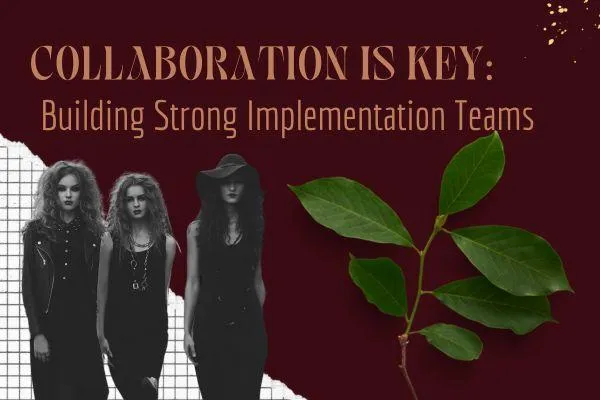
Empowering Businesses with Sustainable Marketing Ecosystems
Make business simple & sustainable with the most powerful & comprehensive marketing system on the market.

Newsroom
Keep up to date with us and our content outside of social media.

Collaboration is Key: Building Strong Implementation Teams
Collaboration is Key: Building Strong Implementation Teams
Collaboration is a critical component of achieving organizational goals. In today's complex and fast-paced business environment, no single individual can possess all the skills and knowledge necessary to successfully implement projects and initiatives. Strong implementation teams require effective collaboration among team members to leverage their collective expertise and achieve success.
Understanding the Role of Collaboration in Achieving Organizational Goals
Collaboration plays a crucial role in achieving organizational goals by aligning team members towards a common objective. When team members collaborate, they share information, ideas, and perspectives, which helps to create a shared understanding of the project or initiative. This shared understanding ensures that everyone is working towards the same goal, reducing the likelihood of miscommunication or conflicting priorities.
Furthermore, collaboration promotes knowledge sharing and innovation. When team members collaborate, they bring their unique perspectives and experiences to the table, which can lead to new insights and creative solutions. By pooling their knowledge and expertise, team members can develop more robust strategies and approaches to achieve their goals.
Additionally, collaboration helps to identify and address potential roadblocks. When team members work together, they can identify potential challenges or obstacles early on and develop strategies to overcome them. By addressing these roadblocks proactively, teams can minimize delays and disruptions, ensuring that projects stay on track.
The Benefits of Collaborative Teamwork: Improved Performance and Efficiency
Collaboration has numerous benefits for teams and organizations. One of the key benefits is improved decision-making. When team members collaborate, they can draw on a wider range of perspectives and expertise, leading to more informed decisions. By considering multiple viewpoints, teams can identify potential risks or opportunities that may have been overlooked by an individual working alone.
Furthermore, collaboration improves communication within teams. When team members collaborate effectively, they share information openly and transparently. This reduces the likelihood of miscommunication or misunderstandings, leading to fewer errors and mistakes. Clear and effective communication is essential for successful implementation, as it ensures that everyone is on the same page and working towards the same goal.
In addition to improved decision-making and communication, collaboration also increases efficiency and productivity. When team members collaborate, they can divide tasks and responsibilities based on individual strengths and expertise. This allows team members to focus on what they do best, resulting in higher-quality work and faster completion times. Collaboration also promotes accountability, as team members are responsible for their individual contributions to the team's overall success.
Key Elements of Successful Collaboration: Communication, Trust, and Shared Goals
Effective communication is a fundamental element of successful collaboration. Team members must be able to express their ideas and opinions clearly and concisely, ensuring that everyone understands the goals and objectives of the project. Additionally, active listening is crucial for effective collaboration. Team members must listen attentively to one another, seeking to understand different perspectives and ideas.
Trust is another essential element of successful collaboration. Team members must trust one another's abilities and intentions, knowing that everyone is working towards a common goal. Trust allows team members to be open and honest with one another, fostering a supportive and collaborative environment.
Shared goals are also critical for successful collaboration. When team members have a clear understanding of the project's objectives, they can align their efforts towards achieving those goals. Shared goals help to create a sense of purpose and direction within the team, ensuring that everyone is working towards the same outcome.
Building a Collaborative Culture: Strategies for Fostering Teamwork and Cooperation
To foster collaboration within teams, organizations should encourage open communication and active listening. This can be achieved by creating opportunities for team members to share their ideas and perspectives, such as through regular team meetings or brainstorming sessions. Additionally, organizations should provide training or resources on effective communication techniques to help team members improve their communication skills.
Fostering a culture of trust and respect is also crucial for building a collaborative environment. Organizations should promote trust by recognizing and rewarding collaborative behavior, such as through team-based incentives or recognition programs. Additionally, leaders should model collaborative behavior themselves, demonstrating the importance of trust and respect within the team.
Promoting teamwork and cooperation through team-building activities can also help to foster collaboration. These activities can range from informal social events to more structured team-building exercises. By providing opportunities for team members to get to know one another on a personal level and build relationships, organizations can create a supportive and collaborative environment.
The Role of Leadership in Facilitating Collaboration and Creating a Supportive Environment
Leaders play a critical role in facilitating collaboration within teams. They must model collaborative behavior themselves, demonstrating the importance of collaboration to the team. Leaders should actively seek input from team members, encourage open communication, and value diverse perspectives.
Additionally, leaders must create a supportive environment that encourages collaboration. This includes providing the necessary resources and support for collaboration to thrive, such as access to technology or training on collaboration techniques. Leaders should also establish clear expectations for collaboration within the team, ensuring that everyone understands the importance of working together towards a common goal.
Furthermore, leaders should provide guidance and support to team members as they navigate the challenges of collaboration. This includes addressing conflicts or disagreements that may arise and providing coaching or mentoring to help team members develop their collaboration skills.
Overcoming Common Challenges to Collaboration: Conflict, Resistance, and Miscommunication
Collaboration is not without its challenges. Conflict can arise when team members have different perspectives or ideas about how to achieve the project's goals. However, conflict can be managed through effective communication and conflict resolution strategies. By encouraging open dialogue and actively listening to one another's concerns, teams can find common ground and develop solutions that address everyone's needs.
Resistance to collaboration can also be a challenge. Some team members may be hesitant to collaborate due to a fear of losing control or a lack of trust in their colleagues. However, resistance can be addressed through active listening and addressing concerns. By understanding the reasons behind the resistance and addressing them directly, leaders can help team members overcome their hesitations and embrace collaboration.
Miscommunication is another common challenge to collaboration. Miscommunication can lead to misunderstandings, delays, and errors. However, miscommunication can be avoided through clear communication and active listening. Team members should strive to communicate their ideas and expectations clearly and concisely, while also actively listening to one another's perspectives and feedback.
Leveraging Diversity and Inclusion to Build Strong Implementation Teams
Diversity and inclusion are powerful tools for building strong implementation teams. When teams are diverse, they bring a wide range of perspectives, experiences, and expertise to the table. This diversity promotes innovation and creativity, as team members can draw on their unique backgrounds to develop new ideas and approaches.
Furthermore, diversity and inclusion help to build stronger relationships within teams. When team members feel valued and included, they are more likely to collaborate effectively and support one another's success. This sense of belonging fosters a collaborative environment where everyone feels comfortable sharing their ideas and opinions.
Additionally, diversity and inclusion help teams identify and address potential roadblocks. When team members come from different backgrounds or have different areas of expertise, they can identify potential challenges or risks that may have been overlooked by a more homogeneous team. By considering diverse perspectives, teams can develop more robust strategies and approaches to achieve their goals.
Best Practices for Collaborative Decision-Making: Consensus-Building, Feedback, and Accountability
Collaborative decision-making is essential for ensuring that all team members are aligned towards a common goal. One best practice for collaborative decision-making is consensus-building. Consensus-building involves seeking input from all team members and working towards a solution that everyone can support. This ensures that all perspectives are considered and that everyone has a stake in the decision.
Feedback is another crucial element of collaborative decision-making. Team members should provide feedback on proposed solutions, offering suggestions for improvement or alternative approaches. This feedback helps to identify areas for improvement and promotes continuous learning within the team.
Accountability is also essential for collaborative decision-making. Team members must be responsible for their actions and decisions, ensuring that they follow through on their commitments. By holding team members accountable, teams can ensure that decisions are implemented effectively and that everyone is working towards the team's goals.
Measuring the Impact of Collaboration: Metrics for Evaluating Team Performance and Success
Measuring the impact of collaboration is essential for evaluating team performance and success. Metrics can help organizations assess the effectiveness of collaboration and identify areas for improvement. Some metrics that can be used to evaluate collaboration include:
- Team satisfaction: Surveying team members to assess their satisfaction with the level of collaboration within the team.
- Communication effectiveness: Measuring the frequency and quality of communication within the team.
- Decision-making efficiency: Assessing the speed and accuracy of decision-making within the team.
- Project outcomes: Evaluating the success of projects or initiatives that were implemented collaboratively.
By measuring these metrics, organizations can gain insights into the effectiveness of collaboration within their teams and make adjustments as needed to improve performance.
The Future of Collaboration in Building Strong Implementation Teams
Collaboration will continue to be essential for achieving organizational goals in the future. Strong implementation teams require effective collaboration among team members to leverage their collective expertise and achieve success. Leaders must continue to foster a culture of collaboration and provide the necessary resources and support for collaboration to thrive. By doing so, organizations can build strong implementation teams that are capable of achieving their goals and driving success.
Attract & Convert
Embrace cutting-edge technologies to help you attract your ideal clients and convert them with a data driven pipeline that is automated and easy to manage.
Spend more time IN your ZONE, not in your business
The common issue most business owners have? They are trapped IN their business. Instead of being able to spend time doing what they are passionate about, they wind up having to spend way more time on all the other elements of business. Our platform solves many of these issues by automating common steps.
Enhance customer experience
Nurture your leads with quality, tailored, multi-channel follow up campaigns to engage and encourage responses (this means you get greater conversions).


Everything You Need To Grow Your Business
An all in one platform designed to help you create an omni-present marketing approach, even when you are out-of-office!
Websites & Funnels
Create beautifully branded websites and funnels that convert your lookers to buyers!
Automations & Multi-Channel Campaigns
Optimize your lead generation process with conversion-focused strategies and tools to make follow-up easy.
Evergreen Sales Opportunities
Seamlessly integrate your membership & course offerings with automations so you make money while you sleep.


Why You Will Love It
Automate repetitive marketing tasks, nurture leads, and drive customer engagement with our robust marketing automation solution.
Time-Saving Efficiency
Automate repetitive marketing tasks, freeing up valuable time to focus on strategic initiatives and creativity.
Personalized Customer Journeys
Create targeted, personalized customer journeys based on user behavior, driving higher engagement and conversions.


